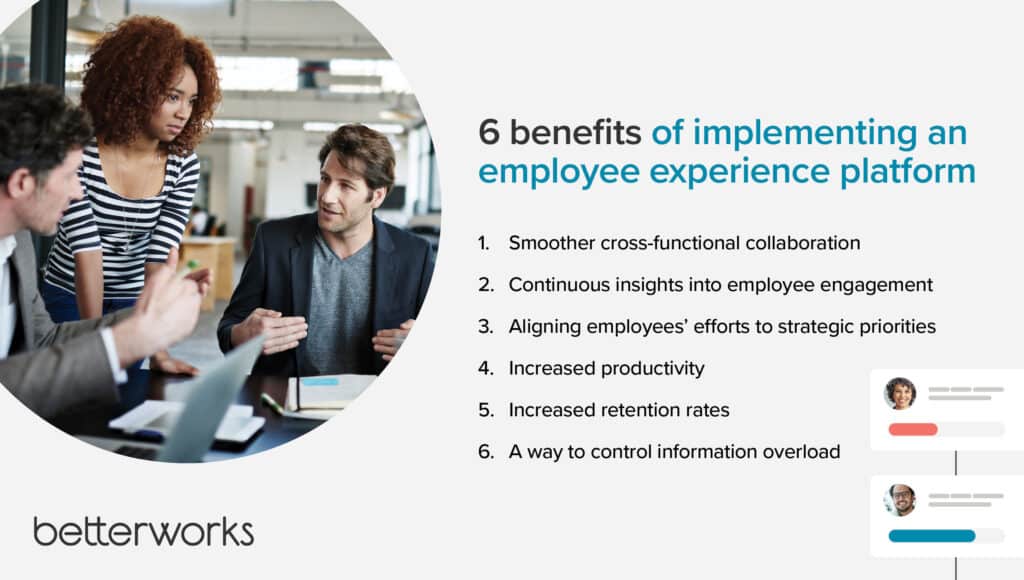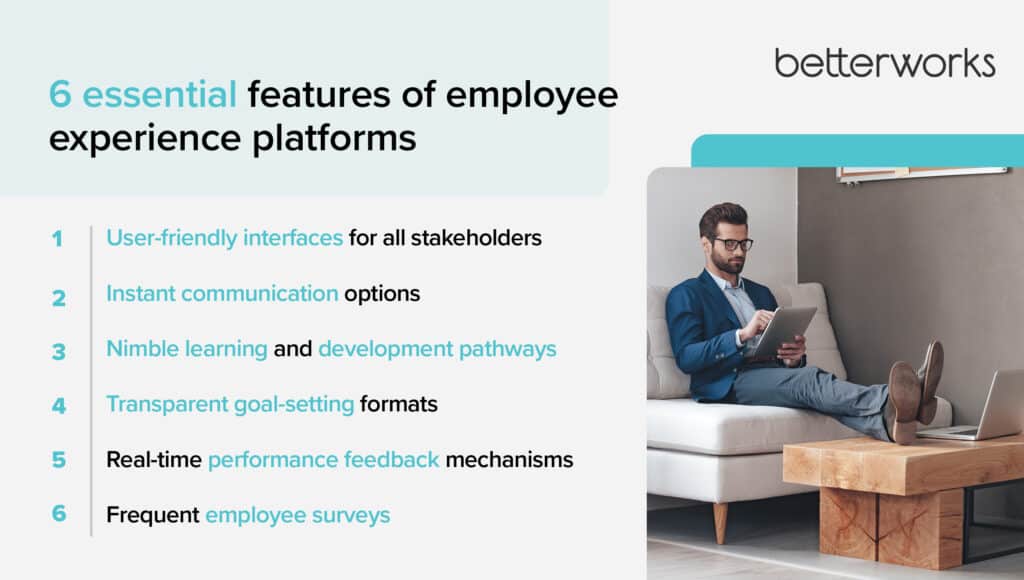Employee experience is the sum of an employee’s encounters with your company from the application process to their last day. An employee experience platform helps HR leaders and managers oversee all aspects of the employee workplace journey, including daily performance, feedback, and long-term goals in a comprehensive, cohesive way.
A 2021 Forrester research study commissioned by Microsoft found that 60% of business leaders were already spending more than $100,000 on employee experience technology, with a 16% increase planned over the coming two years. This spending is often scattered across solutions, which makes it hard to deliver a truly unified experience. It’s little wonder that 84% of employees and 71% of business leaders say they wish they had access to a single, integrated employee experience platform.
Let’s explore how employee experience platforms have evolved in recent years to contribute to stronger employee engagement, improved retention rates, and increased productivity.
What is an employee experience platform?
Employee experience platforms cover a broad category of software that helps HR leaders, managers, and employees improve employee engagement, workforce development, and alignment between individual goals and overall business objectives.
Employee experience platforms have become increasingly important in recent years not just as a one-stop source of information, Josh Bersin argues, but also because companies found that human capital management (HCM) software and HR information systems (HRIS) weren’t sufficiently delivering the information people needed when they needed it. They were not built to accommodate the evolving needs of a workforce.
Employee experience platforms are less about buying one complicated software system that does everything and more about creating a unified employee experience that connects every application they might need. You no longer have to choose a single vendor (or set of vendors) with an HCM or HRIS offering.
Instead, your employee experience system should flexibly accommodate different vendors handling onboarding, benefits, payroll, and learning and development (L&D), performance management, employee engagement, and other functions — all under one portal that offers a user-friendly experience for your employees. If a vendor needs to be changed out, this can be done smoothly and with much less disruption to employees.
Employee experience platforms are also designed to meet the high expectations that today’s users have. Employees expect HR systems to have the same ease of use as their consumer-focused apps — and they expect to access these platforms on all devices.
Learn about some of the HR functions that can be included within employee experience platforms while helping employees track their personal information, professional development, and performance against goals.
Benefits and compensation
Employee experience platforms can simplify the onboarding process by moving the “paperwork” process online and automatically sending it to employees before their first day of work.
This extends into the ongoing employee experience, as they can access any benefits and compensation information at any time. Updating their personal information only requires one login, and they can also access resources pertaining to any component of their total rewards package.
For example, instead of different systems and interfaces for health insurance, commuter benefits, and employee discounts, workers can access all of that through one login.
Performance Management: Goal setting, conversations, and feedback
These platforms can house everything related to performance management, including goal-setting processes, manager-employee conversations, peer feedback, employee recognition, employee surveys, and calibration. You want all information related to short- and long-term goals to be accessible and up to date in one place that managers and employees alike can access it.
One benefit of including goal setting within your employee experience platform is providing clarity about what’s expected of employees and what they’re trying to achieve. Documenting that within a central platform holds managers and employees accountable while enabling easy tracking for employees and data insights for HR. These platforms can also help employees see how their goals relate to team and organizational goals.
Learning and development
L&D can take place in a variety of locations and formats, including in-person classes, online education, and on-the-job experience. Employee experience platforms can collect all that information in one place to show what an employee is learning and what’s available to them.
Having L&D information in one place also helps managers connect learning opportunities to employee goals and their desired career paths. This creates a uniform framework for managers to guide employees along their learning journey.
Payroll
HR and finance teams have long relied on technology to track payroll, but these systems don’t always communicate with other key sources of employee information.
By having payroll information within a broader, interconnected platform, organizations can better track finance and accounting operations, manage employee agreements, and stay in compliance with laws and regulations across jurisdictions.

6 benefits of implementing an employee experience platform
Employee experience platforms can help your organization focus on improving employees’ day-to-day work lives, which contributes to continuous growth, higher satisfaction, and better business outcomes.
Smoother cross-functional collaboration
Collaboration between departments is essential for sustained growth, and successful collaboration requires setting and sharing clear expectations and goals.
Employee experience platforms with performance management features allow managers to set short-term and long-term goals for team and company-wide initiatives. Goal-setting ensures each person, regardless of their department, is clear about their responsibilities — and those of their colleagues, and has transparency into the goals of other teams. This enables everyone to see how their work impacts other departments and strategic business initiatives.
Continuous insights into employee engagement
Employee engagement is a measure of how enthusiastic and involved workers are in their daily work and the workplace in general. Recent Gallup research found that only 32% of employees in the U.S. are actively engaged in their work, down from 34% the previous year. And, as of the second quarter of 2022, 18% of employees were actively disengaged. The ratio of engaged to disengaged employees is at the worst levels in almost a decade.
Employee experience platforms contribute to improved engagement by helping employees understand how their work impacts the company and by facilitating and capturing communications between managers and employees that can be used in goal realignment and performance reviews. Those conversations can include coaching, performance observations, recognition of positive performance, and discussions about professional development opportunities.
Employee experience platforms also give HR leaders and managers an aggregate view of employee engagement through pulse surveys and performance tracking.
Aligning employees’ efforts to strategic priorities
When people understand how their job role contributes to the organization’s business goals and outcomes, they can bring a greater sense of purpose and drive to their work.
Business leaders set organizational priorities, empowering managers and department heads to set specific goals and markers for progress for their teams and reports. Managers are then responsible for communicating those goals, motivating employees, encouraging employees to set their own goals in alignment with business objectives, helping them to connect their daily work to strategic objectives.
Employee experience platforms support managers in that responsibility by facilitating more intentional and regular communications, clear goal-setting processes, actionable performance and personal development conversations, and learning and growth opportunities..
Increased productivity
In the most immediate sense, employee experience platforms increase productivity by freeing up managers and employees from having to access multiple disparate HR systems. This helps them spend more time on their core duties.
Productivity also increases as a result of higher employee engagement and alignment.. According to Gallup, the top 25% of companies with high employee engagement showed decreased absenteeism, higher profitability, and better sales productivity than the least-engaged 25% of companies.
Increased retention rates
Companies are focusing on employee retention more than ever. Labor shortages and rising costs mean that hiring new employees is increasingly expensive. According to the Society for Human Resource Management, the average cost per hire in 2022 was nearly $4,700. Gallup research reveals the cost can be up to 2 times the annual salary of an employee.
Effective employee retention strategies generally have two characteristics in common — listening to what employees need and finding ways to meet those needs. Some proven ways to increase employee retention include investing in your employees’ growth, supporting their well-being, and finding opportunities for them to excel.
Data suggests that failing to provide growth opportunities or maximize employee skill sets harms retention. LinkedIn’s 2022 Workplace Learning Report revealed that companies with strong internal mobility retain employees for an average of 5.4 years, or 2.5 years longer than companies that struggle with mobility. When employees believe their current role doesn’t use their skills effectively, the report found, they’re 10 times more likely to seek other employment.
Employee experience platforms allow managers to explore internal mobility pathways and career pathing capabilities. These features improve discussions about upskilling and training because employees can see what’s possible and how available opportunities can be achieved — all without needing to find a new job.
A way to control information overload
Sometimes variety can be a problem. Multiple sources of information can lead to confusion and frustration for everyone in the workplace when materials aren’t kept up to date or differ by location.
Without a clear strategy and plan, cobbled together systems of multiple tools can contribute to this problem. The Forrester report found 34% of business leaders invested in six or more tools to meet their employee experience goals. Meanwhile, 50% of employees said there are too many separate tools, apps, and resources to do their jobs effectively.
A unified employee experience system allows you to organize all relevant information in a way that employees can access the information they need without worrying about its accuracy or completeness.

6 essential features of employee experience platforms
The right employee experience platform for your organization will depend on your structure, industry, number of employees, and other factors, but these features should all be considered essential.
User-friendly interfaces for all stakeholders
Regardless of how tech-savvy individual employees are, a clunky interface or a difficult service delivery system will hamper your employees and potentially decrease their willingness to use the system. This defeats the purpose of adopting such a system.
The more user-friendly the platform, the less training your company needs and the more quickly employees will use it.
Instant communication options
When employee experience platforms make communication easier to do and track, you’re less likely to encounter misunderstandings and conflicts among team members.
Communication within the platform and in the notifications generated can help employees, managers, and HR team members quickly answer questions on topics ranging from development plans, opportunities to work on new projects, compensation, performance, and more.
Nimble learning and development pathways
L&D features are essential in modern employee experience platforms. When designed well, they empower employees to quickly access their learning options and progress — putting the skills development journey in their hands.
These learning paths are also then visible to managers and HR leaders so they can offer guidance and track development against both employee and business goals.
Transparent goal-setting formats
As managers work with employees to set goals, those goals should be viewable and trackable in real time through your employee experience platform. Offer templates for setting goals and tracking progress. Provide transparency that enables employees to see how the puzzle pieces fit together —how their goals relate to other organizational objectives.
Real-time performance feedback mechanisms
Sharing feedback can be tough, but employee experience platforms make the process easier. When technology enables performance feedback in real time, manager-employee discussions can be more informed and focused on the work rather than feeling personal.
These platforms can help managers give regular and structured feedback in one place that they and employees can access on demand.
Frequent employee surveys
Feedback isn’t just for employees — it’s for leaders and managers, too. Modern pulse surveys collect feedback on leadership performance and a variety of other issues anonymously, alerting organizational leaders to emerging problems quickly so they can address them quickly.
Create better business outcomes
Businesses are increasingly connected by technology, whether in the tools they use each day or because they have hybrid or remote workforces. At the same time, more information than ever is being generated and needs to be analyzed in the course of day-to-day operations.
All of this information can be overwhelming when it’s unorganized or spread across too many tools and systems. Employee experience platforms create a single interface and access point without sacrificing the flexibility gained from using a variety of vendors. The benefits include reduced costs, fewer duplicative systems, and a single trusted source of information.
These platforms also improve the employee experience by allowing for all pertinent employee data to be accessible in a single portal. Managers and employees can have productive conversations around goals, performance management, L&D, and more. They can document these discussions and track progress in one place, which keeps everyone informed and accountable.
Investing in an employee experience platform helps HR leaders and managers manage more effectively at scale, improve engagement and productivity, and drive better business outcomes.
Discover the best employee engagement software every HR leader should use.


